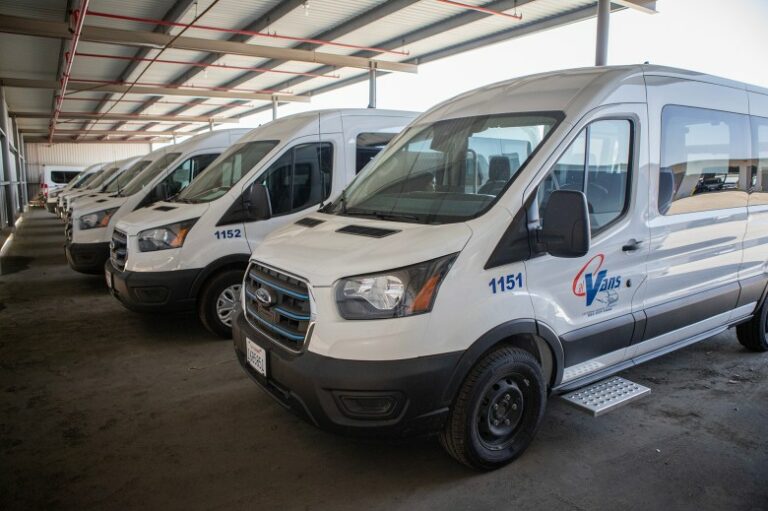CalVans Navigates California’s EV Mandate
In California’s Central Valley, the CalVans program is a vital service, transporting thousands of farmworkers to and from the fields. Now, this program faces a pivotal test of the state’s ambitious climate policies: electrifying its fleet. This effort highlights the challenges of implementing these policies in rural and economically disadvantaged communities.
Established after a tragic 1999 crash that killed 13 farmworkers, the Central Valley transit agency leases strictly monitored vehicles, forming vanpools for workers and their employers. CalVans provides a critical, safe transportation solution for farmworkers traveling to California’s vineyards, orchards, and berry fields. Regulators identify the program as a significant answer to a persistent problem: the often unsafe and unregulated transportation of agricultural workers.
The program is popular, operating nearly a thousand vanpools each season, and labor contractors compete to reserve vehicles. Despite its success, CalVans now faces a new regulatory hurdle. California’s climate law mandates a phased transition to zero-emission vehicles as part of its goal to slash emissions and achieve carbon neutrality by 2045. The California Air Resources Board (CARB) requires all local government agencies to replace their fleets with zero-emission vehicles, either purchasing only electric vehicles starting in 2027 or ensuring their vehicles are zero-emission over time.
The mandate requires 10% of the fleet to be zero-emission by January 2025, increasing to 25% by 2028, 50% by 2031, 75% by 2033, and 100% by 2035. CalVans officials acknowledge the need to comply, but the program’s specialized nature poses unique difficulties. They plan to pilot electric vehicles this year, which will serve as a crucial test of implementing clean air policies in rural and disadvantaged areas.

Electric vans parked at the CalVans main office in Visalia, May 2, 2024.
The San Joaquin Valley, a heavily agricultural region, suffers from some of the worst air quality in the nation, harming residents who are disproportionately Latino and low-income. CARB’s spokesperson, Kate Lamb, emphasized the importance of ensuring these communities benefit from the transition to zero-emission vehicle technology and clean air.
Lamb declined to give specific compliance advice, and indicated CalVans might not need to adhere to the mandate depending on how the agency is classified. She also noted exemptions are available if EVs are not readily available. Despite the challenges, CalVans officials are committed to making the transition.
Román Partida-Lopez, senior legal counsel for transportation equity at the Greenlining Institute, said the state should consider alternative modes of transportation. Many climate policies center personal electric vehicles, and “are only part of the solution.”
Specific Challenges
A significant challenge is the absence of electric versions of the eight- to 15-person vans. CalVans vehicles are carefully selected to provide safe commutes while avoiding classification as farm labor contractors. This is because the drivers are fellow farmworkers, not professionally licensed drivers.
To address the rule, the agency agreed to buy about 400 Ford electric cargo vans, which will be retrofitted with seating and GPS devices. The purchase fulfills the 2025 EV mandate, and CalVans has received the first dozen vans. However, challenges remain.
CalVans director Georgina Landecho states the agency plans to select farmworker groups to test the new vans later this year, once they receive adapters for the Tesla supercharger network. The lack of chargers in rural areas remains a significant hurdle, along with charging times that could extend to two hours per charge according to Model 1 vice president T.J. Matijevich.

The interior of an electric van.
Farmworkers drive the vans home, where EV chargers are less common, unlike traditional public transit. Matijevich is working on providing alternatives, which includes free home chargers, and potentially a centralized charging depot.

Rafaela Treviño sits in the CalVans van she uses.
Daily Realities
Electric vans can run up to 125 miles on a full charge, but farmworkers often drive further each day. Jose Palma, a longtime farmworker, drives his coworkers each day with commutes sometimes exceeding 50 miles.
The CalVans program offers a safer commute for Palma and his coworkers, saving them from insurance and maintenance expenses. The program charges fares based on mileage, and the van “has everything that the law requires,” he said.

Jose Palma trims trees in a citrus orchard.
Past Efforts and Future Funding
CalVans has long understood the need to transition to cleaner vehicles. A 2017 CARB grant of $6 million led to a hybrid vehicle conversion test, but it was unsuccessful because the technology was not suitable for the demands of farm work. CalVans is now opting for EVs out of necessity.
The electric vans cost over twice as much as gas versions, and the agency relies on a combination of van leases and county subsidies for funding support. They’re now seeking grants to add nearly 600 electric vans across 16 housing projects.
Lamb from the Air Resources Board noted other state programs to subsidize electric vehicle purchases and charger installations, as well. Future funding is uncertain because of Gov. Gavin Newsom’s proposed cuts to electric vehicle programs to address a $56 billion deficit. Partida-Lopez at the Greenlining Institute urges the state to assist CalVans in covering the expenses while it is also lobbying for funding in a proposed climate bond measure. However, concrete plans haven’t materialized.
Landecho wants to avoid passing the costs of new vehicles onto farmworkers. “It’s folks who are just trying to get home from work,” she said.



